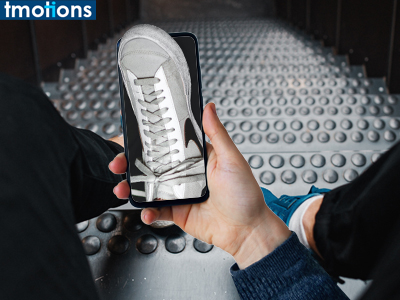Newest Wave of Digital Trade
Digital commerce has the potential to provide a more personalized and interactive shopping experience that can replicate many of the benefits of the in-store experience. In particular, digital commerce can provide consumers with the ability to touch and try products before buying them. This would allow consumers to determine the quality, craftsmanship, dimensions and fit of a product before making a purchase. Additionally, digital commerce can provide consumers with the transparency and control that they need to build trust and confidence in their purchases.
Future of Immersive Technology
The future of immersive technology in business is looking very bright. With the release of products like the Oculus Rift and HTC Vive, businesses are starting to take notice of the potential that virtual reality has to offer.
Companies are already beginning to experiment with virtual reality (VR), augmented reality (AR), and mixed reality (MR) technologies to create more immersive and realistic experiences for their customers and employees. These technologies have the potential to revolutionize the way businesses operate and interact with their customers and employees.
Also Read : Microsoft Dynamics 365 For Sales
Some of the Potential Applications of Immersive Technology in Business include:
- Training employees in a realistic and immersive virtual environment
- Improving customer service by providing immersive and personalized experiences
- Creating more realistic and immersive product demonstrations
- Improving communication and collaboration between employees
- Enhancing presentations and conferences with virtual and augmented reality
As we move into the future, it’s becoming increasingly clear that immersive technologies like augmented reality (AR) and virtual reality (VR) are no longer just novelties used for gaming and entertainment. These technologies are starting to be adopted for practical purposes by businesses across a variety of industries.
From Innovation to use, Immersive Technology
The key to winning in digital commerce is to create immersive product and service experiences that give consumers the confidence they need to make a purchase. By investing in immersive technologies, brands can create these experiences at scale and connect with consumers in a way that is truly impactful.
Interestingly, our research shows that leading consumer brands are already investing in immersive experiences for commerce.
64% of brands are starting to invest in these experiences in some way, whether it be through uploading 3D models on product pages, curating personalized make-up palettes, or hosting virtual fashion shows.
However, many brands are not investing in ways that are scalable or connected across the business. This lack of scalability and cohesion could limit the effectiveness of these investments.
These technologies are not only more sophisticated than ever; they are also very affordable and accessible for brands. This makes it possible for brands to create immersive shopping experiences that are realistic, engaging, and personalized.
Interacting without being Close
Here are some of the ways they are creating meaningful experiences that blur digital and physical boundaries to solve the problem of proximity in digital commerce.
Put me there
With the help of VR technology, businesses can create immersive experiences that make the journey to purchase more captivating and insightful. For example, Emirates uses VR technology to offer 3D models of the cabin on its website. Which allows travelers to make informed choices when selecting their seats and preview the environment to make the most of their time on the board later.
Similarly, beauty legend Dior launched a VR store based on its flagship location in Paris. Which encourages customers to browse and connect to the products and brand.

See it on me
In-store experiences are becoming more and more important to consumers, as they are looking for ways to try out products before they buy them. AR offers a solution that allows consumers to virtually try on products, such as makeup or shoes, and get a sense of how they will look before they make a purchase.
Also Read: Microsoft Dynamics 365 and nopCommerce
This can be a great way for brands to provide a more immersive experience for their customers and answer any questions they may have about fit or size. However, brands must be mindful of consumers’ concerns about data privacy and be transparent about how personal data is being used to provide such experiences.

Teach me more
In today’s world, interactive and immersive experiences are becoming more and more popular as a way to educate consumers about products. This is especially true in the automotive and electronics industries, where companies are using Augmented Reality (AR) to give consumers a “hands-on” education about their products.
One example of this is Toyota’s AR experience, which allows consumers to explore different car models and features before they make a purchase. This not only helps educate consumers about the products they are interested in but also builds engagement with the brand.
Similarly, Bang & Olufsen’s AR app allows consumers to see how products would look in their own homes, test out the sound quality, and learn about different features and options. This not only helps consumers make informed decisions about purchases but also allows them to contact the store with any questions they may have.
Overall, immersive experiences are a great way to educate consumers about products and build engagement with brands.
Also Read: All You Need To Know About NopCommerce
There are a number of reasons why businesses should start adopting AR/VR technology.
-
- These technologies can be used to improve communication and collaboration among employees.
- By using AR/VR, businesses can create virtual meeting spaces where employees can interact with each other and with digital content in a more natural and immersive way.
- The advantage of adopting AR/VR technology is that it can be used to create more realistic and engaging customer experiences.
For example, businesses can use AR/VR to give customers virtual tours of their products or services or to create immersive shopping experiences.
- AR/VR can also be used to improve employee training and development.
- By using AR/VR, businesses can create realistic, immersive simulations that can be used to train employees on how to use new products or services, or to respond to potential emergencies.
Overall, there are a number of compelling reasons for businesses to start adopting AR/VR technology. These technologies have the potential to improve communication and collaboration. These create more realistic and engaging customer experiences, and improve employee training and development.
To learn more about how immersive experiences can bring new value to consumers. Visit: https://tmotions.com/ and Drop us a note at info@tmotions.com!!















